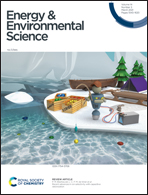Promotion of oxygen reduction reaction on a double perovskite electrode by a water-induced surface modification†
Abstract
Highly efficient air electrodes are a key component of reversible fuel cells for energy storage and conversion; however, the development of efficient electrodes that are stable against water vapor remains a grand challenge. Here we report an air–electrode, composed of double perovskite material PrBa0.8Ca0.2Co2O5+δ (PBCC) backbone coated with nanoparticles (NPs) of BaCoO3−δ (BCO), that exhibits remarkable electrocatalytic activity for oxygen reduction reaction (ORR) while maintaining excellent tolerance to water vapor. When tested in a symmetrical cell exposed to wet air with 3 vol% H2O at 750 °C, the electrode shows an area specific resistance of ∼0.03 Ω cm2 in an extended period of time. The performance enhancement is attributed mainly to the electrocatalytic activity of the BCO NPs dispersed on the surface of the porous PBCC electrode. Moreover, in situ Raman spectroscopy is used to probe reaction intermediates (e.g., oxygen species) on electrode surfaces, as the electrochemical properties of the electrodes are characterized under the same conditions. The direct correlation between surface chemistry and electrochemical behavior of an electrode is vital to gaining insight into the mechanisms of the electrocatalytic processes in fuel cells and electrolysers.



 Please wait while we load your content...
Please wait while we load your content...
